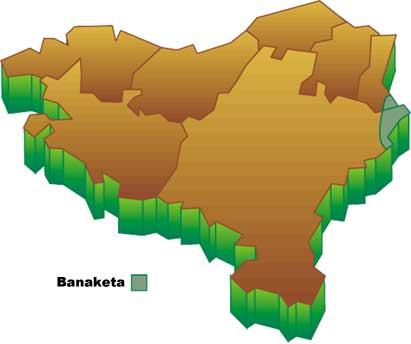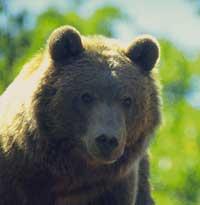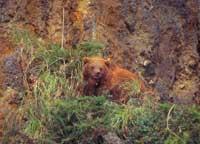Last chance for Pyrenean bears

Admired sacred beast and hated enemy at once. The mammal that has created more myths and legends in this region. Elegant and discreet. This is the bear, a magnificent animal that still occasionally visits the richest areas of Euskal Herria. But how long will this treasure last that the Suletinos once considered our ancestor? Do we have to say goodbye… forever?
Due to its popularity and its deep conservation, we will only mention the most peculiar characteristics of the brown bear in the Pyrenees. Among the different forms of this large mammal worldwide, the Pyrenees is one of the smallest, with a weight ranging between 80 and 250 kilos. As for food, and as the large and flattened indicate, it is omnivorous and largely herbivorous.

75-80% of the food consists of herbs, fruits and other plants, while the remaining 25% is of animal origin. Within it, mammals represent between 12-15%, insects between 7-9% and micromammals 1%. Cattle represent between 6% and 8% of the diet, so it is evident that the bear is not an overthrown cattle killer, something many people claim. As for the habitat, fleeing human pressure, it takes refuge in the most hidden and difficult areas of the mountain. It can be said that it is a forest animal in general, but in addition to beech, fir, pine and other forests, it explodes alpine pastures and formerly chestnut and oak. Undoubtedly, it is an indicator of the good health of the mountain ecosystem.
Heat occurs in late spring or early summer. Due to the shortage of specimens, the encounters between males and females are difficult and to make the most of them is induced ovulation. That is, the male constantly covers it so that fertilization occurs causing ovulation of this female. The young (one or two) will launch into the world with the mother in the hibernation hole. In the Pyrenean population, the only births confirmed in recent years have been those born in 1989 and last year.
So what is the state and future of this magnificent mammal? Although solid populations of brown bears exist in the north and east of Europe, in the south we find relatictic populations. In the Iberian peninsula there are between 60 and 80 bears in the Cantabrian Mountains and only 8 specimens in the Pyrenees. Of these, only one or two are those who periodically visit the territories of Navarre and Zuberoa. In 1995, for example, remains of the bear were found at two points in the Roncal valley. This situation, however, was very different. Thus, in the Middle Ages, the species spread from the Pyrenees to Galicia.
By then, the rivalry between the man and the bear had begun and became increasingly hard. Unable to resist the attacks of humanization, about 200 years ago the Cantabrian and Pyrenean bears separated. Then, XIX. and especially XX. Throughout the 20th century, grazing, hunting, poisons, forestry, tourism and, in general, the transformations of all kinds applied to the montane environment caused a drastic reduction of the local population. Illegal hunting seems to be the most affected factor in recent years.

Therefore, the current situation of the bear is vital. The last specimens are Aspe and Ossau (Biarnon) and Hecho and Ansón (Aragón). The survival of this population is vital and it is essential to maintain the habitat in its entirety. The maintenance of an ideal habitat for the conservation of the good requires the regulation of all activities carried out in these places and, consequently, the overcoming or reorientation of many economic interests. Are people willing to do it? No, of course, if it is to the detriment of them.
The measures to protect the Pyrenean environment must be aimed at improving the living conditions of all living beings, including man. All roads that do not take into account this factor will find a logical attitude contrary to the neighbors of the town, and will occur unexpectedly. Unfortunately and especially because of the attacks on livestock, the bear continues to generate hatred and fear among many of the inhabitants of the Pyrenees. For years they have had to endure this problem without compensation.
Although the current situation is very different (as long as the bear has attacked the animals since 1981, the government has assumed the payment of the damage), some prefer that the bear disappear from its surroundings. It is clear, therefore, that it will be difficult for the bear and man to live together in the pyrenean ecosystem and without excessive damage, but after all that is the goal.

Thus, the future is dark for this animal and the projects that have been implemented in recent years have not managed to stabilize the bear population. The baby born in 1995 opened hope among conservationists, but despite this, we have less oaks than ever. The latest effort is the LIFE project signed by the States of France and Spain. LIFE is a programme for the protection of endangered species in Europe that focuses on habitat protection and the last specimens, population monitoring and, finally, the promotion of information and awareness.
Within this project, three bears from Slovenia are expected to enter the Central Pyrenees in the French area this spring and later. This is the only opportunity to make this population viable with so few specimens. In any case, it is clear that for the conservation of the bear will not be enough with the introduction of new specimens, it is essential to maintain the quality and tranquility of the habitat.
So we'll see what happens to one of the coolest animals in the area. However, in a time when technology is more advanced than ever and in which we claim more than ever the environment, ecology and “green” behaviors, human beings do not show the capacity to protect this species.
Species: Ursus arco Family: |





